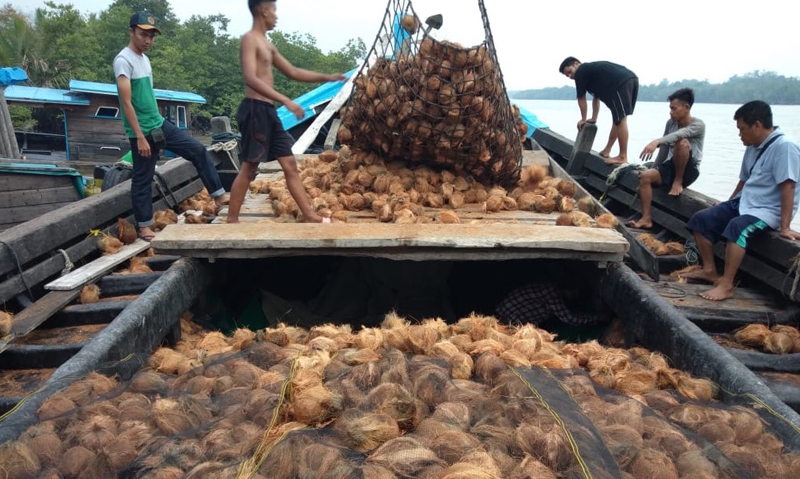About Coconuts
Coconuts from Indonesia
Coconuts are a socioeconomically important palm in Indonesia, owned mostly by smallholders. Indonesia has the largest coconut palm-growing areas in the world, followed by the Philippines and India. About 6.6 million Indonesian farmers rely for their main source of income on coconut and coconut based-products.
Coconut palms have geographically spread and been cultivated in almost every province of Indonesia. Riau, North Sulawesi and East Java are the first, second and the third largest coconut producing provinces, respectively. It is a major source of income for ca. 6.3 million farmers.
Every part of the palm is useful and becomes source of healthy foods and beverages, houses, furniture, handicrafts, and bioenergy. Various traditional foods in Indonesia use coconut as key ingredient.
Coconut shell is processed into Coconut Coir, Coir Yarn, Coco peat, and mat. Coconut water is processed into Coconut Drink, Nata de Coco, Coconut Vinegar, and Coconut Sauce. From coconut meat a number of products are traded such as Coconut Flour, Coconut Milk, Coconut Butter, Virgin Coconut Oil, Copra, and Young Coconut. In addition to being processed into food, Indonesia also develop processed coconut products into doormats and car seat fillers.
Technological and institutional innovations for smallholder in coconut development become important strategies. Producing high value coconut products, establishment of seed farms, replanting of senile palms, pest and disease management, synergy among industries, farmers, and governments as well as research on finding more innovative technologies and technology transfer to solve existing problems are required to ensure the sustainability of coconut sector. Coconut is contributing to national income since its export reached more than USD 1.3 billion.
Why is a coconut plantation more sustainable than a palm oil plantation?

High Density of palm oil plantation in Malaysia
Coconut forests in SE Indonesia: requirement of larger distance of planted coconut palm trees and much taller growth with less crown diameter allow diversity, influx of natural sunlight and rain and therefore survival of flora and fauna. Monkeys, lizards, wild boar and bird – just to name some species – are able to survive as well as 60% of original fauna. Not the perfect model nor indigenous wild habitat, but way more sustainable than a palm oil monoculture.
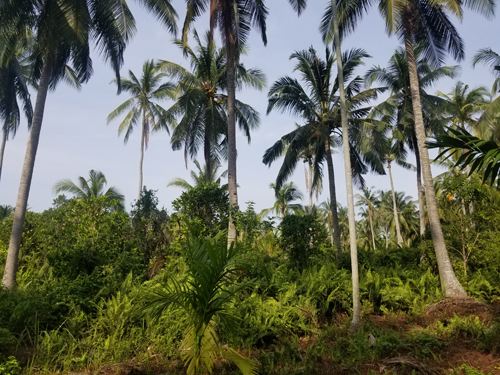 Sustainable Coconut harvest of our farmers in Sumatra.
Sustainable Coconut harvest of our farmers in Sumatra.
Sensible to nature
No invasive polluting machinery
No need of “harvest monkeys” or other “working animals”
Bionesia supports this hard work of our contract farmers as it brings more healthy food on our table.
Bionesia supports products made from coconut husk and – shell
Coconut Husks: Fiber boards
The husk of a fresh coconut is made of very strong fibers. The material between the fibers has a high lignin content. This lignin can act as a natural glue. All you have to do is shred the coconut husk and press it into a mold. Then heat it up to a few hundred degrees and it will turn into a solid board that is similar to medium density fiberboard.

You don’t need to add any additional glue or filler. It can be made from 100% coconut husk. This can be used for construction just like regular fiber boards. Coconut boards can be fabricated into pallets for container shipments and are even being considered for use in car floor boards:
Coconut Husk: Hydroponic Planting Medium
 Ground up coconut husk is a popular hydroponic planting medium. This is especially popular with growing orchids and mushrooms; of course many other plants and flowers thrive in this medium.
Ground up coconut husk is a popular hydroponic planting medium. This is especially popular with growing orchids and mushrooms; of course many other plants and flowers thrive in this medium.
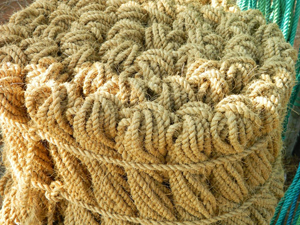
Rope
The fibers of the coconut husk can be separated and branded into a very strong rope. The uses for coconut rope in tropical countries is manifold.
 Erosion Netting
Erosion Netting
The husk of a coconut has long fibers that can easily be woven into ropes and nets. It can be used to cover eroding landscapes help prevent further erosion and to promote plant growth. It then biodegrades without a trace.
 Floor Mats and Rugs
Floor Mats and Rugs
The fibers of a coconut husk can be woven into durable rugs and mat. The course fibers are very popular for door mats.
 Coconut Shell: Activated Carbon
Coconut Shell: Activated Carbon
Coconut shells are some of the best materials for making activated carbon for filters. Coconut shell are very dense and are covered in micropores that are ideal for trapping small contaminant particles. It is also a cheap renewable material that grows all year round. There are many surprising uses for this natural material.
The myth of the coconut pearl
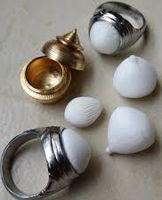 The coconut pearl is alleged to be a coconut-produced gemstone. Claimed to be the rarest botanical gem in the world, the coconut pearl supposedly grows inside the coconut. However, the existence of these pearls is in dispute, and some claim that published photos are hoaxes.
The coconut pearl is alleged to be a coconut-produced gemstone. Claimed to be the rarest botanical gem in the world, the coconut pearl supposedly grows inside the coconut. However, the existence of these pearls is in dispute, and some claim that published photos are hoaxes.
So, where does the myth of the ‘coconut pearl’ come from?
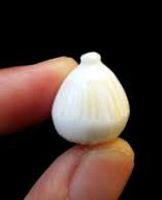 There is indeed a natural coconut pearl, but it is not jewelry …
There is indeed a natural coconut pearl, but it is not jewelry …
Sprouted coconuts or coconut sprouts are the edible spherical sponge-like cotyledons of germinating coconuts. They have a crunchy watery texture with a slight sweetness. They are eaten in coconut-growing countries either as is or as part of various dishes. They are not commercially produced. They are also known variously as coconut pearl, coconut “embryo”, coconut apple, or coconut cotyledon in English
Photos of real coconut pearls
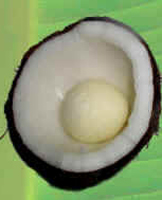 This “spongy mass” is amazingly yummy! It is sweet and moisturous and has very similar texture to cotton candy. It is highly nutritious as well. Sprouted coconuts contain around 66% carbohydrates, around 64% of which are soluble sugars.
This “spongy mass” is amazingly yummy! It is sweet and moisturous and has very similar texture to cotton candy. It is highly nutritious as well. Sprouted coconuts contain around 66% carbohydrates, around 64% of which are soluble sugars.

They contain considerable amounts of dietary fiber and minerals (particularly potassium, manganese, calcium, phosphorus, and magnesium).
Its subtle taste and unique sponge like texture make it quite versatile as a food. Exciting stuff ! We have them at Bionesia factory, fresh and ready to eat!

